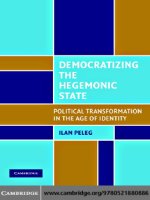cambridge university press the metaphysics of everyday life an essay in practical realism dec 2007 kho tài liệu bách khoa
Bạn đang xem bản rút gọn của tài liệu. Xem và tải ngay bản đầy đủ của tài liệu tại đây (1.12 MB, 271 trang )
This page intentionally left blank
T H E M E T A P H Y SI C S O F E V E R Y D A Y L I F E
In The Metaphysics of Everyday Life Lynne Rudder Baker presents and
defends a unique account of the material world: the Constitution
View. In contrast to leading metaphysical views that take everyday
things to be either nonexistent or reducible to micro-objects, the
Constitution View construes familiar things as irreducible parts of
reality. Although they are ultimately constituted by microphysical
particles, everyday objects are neither identical to, nor reducible to,
the aggregates of microphysical particles that constitute them. The
result is genuine ontological diversity: people, bacteria, donkeys,
mountains, and microscopes are fundamentally different kinds of
things – all constituted by, but not identical to, aggregates of particles.
Baker supports her account with discussions of nonreductive causation, vagueness, mereology, artifacts, three-dimensionalism, ontological novelty, ontological levels and emergence. The upshot is a
unified ontological theory of the entire material world that irreducibly contains people, as well as nonhuman living things and inanimate
objects.
L Y N N E R U D D E R B A K E R is Distinguished Professor of
Philosophy at the University of Massachusetts, Amherst. Her publications include Persons and Bodies: A Constitution View (2000) and
Explaining Attitudes: A Practical Approach to the Mind (1995).
C A M B R I D G E ST U D I E S I N P H I L O S O P H Y
General Editors
JONATHAN LOWE (University of Durham)
WALTER SINNOTT-ARMSTRONG (Dartmouth College)
Advisory Editors:
JONATHAN DANCY (University of Texas, Austin)
JOHN HALDANE (University of St Andrews)
GILBERT HARMAN (Princeton University)
FRANK JACKSON (Australian National University)
WILLIAM G. LYCAN (University of North Carolina at Chapel Hill)
SYDNEY SHOEMAKER (Cornell University)
JUDITH J. THOMSON (Massachusetts Institute of Technology)
RECENT TITLES:
RAYMOND MARTIN Self-Concern
ANNETTE BARNES Seeing Through Self-Deception
MICHAEL BRATMAN Faces of Intention
AMIE THOMASSON Fiction and Metaphysics
DAVID LEWIS Papers on Ethics and Social Philosophy
FRED DRETSKE Perception, Knowledge, and Belief
LYNNE RUDDER BAKER Persons and Bodies
ROSANNA KEEFE Theories of Vagueness
JOHN GRECO Putting Skeptics in Their Place
RUTH GARRETT MILLIKAN On Clear and Confused Ideas
DERK PEREBOOM Living Without Free Will
BRIAN ELLIS Scientific Essentialism
ALAN H. GOLDMAN Practical Rules: When We Need Them and When We Don’t
CHRISTOPHER HILL Thought and World
ANDREW NEWMAN The Correspondence Theory of Truth
ISHTIYAQUE HAJI Deontic Morality and Control
WAYNE A. DAVIS Meaning, Expression and Thought
PETER RAILTON Facts, Values, and Norms
JANE HEAL Mind, Reason and Imagination
JONATHAN KVANVIG The Value of Knowledge and the Pursuit of Understanding
ANDREW MELNYK A Physicalist Manifesto
WILLIAM S. ROBINSON Understanding Phenomenal Consciousness
D. M. ARMSTRONG Truth and Truthmakers
KEITH FRANKISH Mind and Supermind
MICHAEL SMITH Ethics and the A Priori
NOAH LEMOS Common Sense
JOSHUA GERT Brute Rationality
ALEXANDER R. PRUSS The Principle of Sufficient Reason
FOLKE TERSMAN Moral Disagreement
JOSEPH MENDOLA Goodness and Justice
DAVID COPP Morality in a Natural World
The Metaphysics of
Everyday Life
An Essay in Practical Realism
LYNNE RUDDER BAKER
University of Massachusetts, Amherst
CAMBRIDGE UNIVERSITY PRESS
Cambridge, New York, Melbourne, Madrid, Cape Town, Singapore, São Paulo
Cambridge University Press
The Edinburgh Building, Cambridge CB2 8RU, UK
Published in the United States of America by Cambridge University Press, New York
www.cambridge.org
Information on this title: www.cambridge.org/9780521880497
© Lynne Rudder Baker 2007
This publication is in copyright. Subject to statutory exception and to the provision of
relevant collective licensing agreements, no reproduction of any part may take place
without the written permission of Cambridge University Press.
First published in print format 2007
eBook (EBL)
ISBN-13 978-0-511-35486-1
ISBN-10 0-511-35486-X
eBook (EBL)
hardback
ISBN-13 978-0-521-88049-7
hardback
ISBN-10 0-521-88049-1
Cambridge University Press has no responsibility for the persistence or accuracy of urls
for external or third-party internet websites referred to in this publication, and does not
guarantee that any content on such websites is, or will remain, accurate or appropriate.
For my dear friend and colleague,
Gareth B. Matthews,
with gratitude and affection
Contents
Preface
page xiii
1
INTRODUCTION
1
Beginning in the middle
Why do we need a metaphysics of ordinary things?
ID phenomena
Philosophy in the middle of things
Practical realism
What lies ahead
PART I
3
6
11
13
15
21
23
EVERYDAY THINGS
2
The reality of ordinary things
Motivation for nonreduction
The idea of constitution
Is the idea of constitution plausible?
Thinking things into existence?
Conclusion
25
25
32
39
43
47
3
Artifacts
Aggregates and artifacts
Conditions for being an artifact
A Constitution View of artifacts
The significance of malfunction
The ontological status of artifacts
Conclusion
49
49
51
53
55
59
66
4
Human persons
The Constitution View of human persons
Coming into existence: human organisms
and human persons
67
67
ix
72
Contents
Life and death
Quasi-naturalism and the ontological uniqueness
of persons
Three approaches contrasted
Conclusion
PART II
5
82
85
90
93
95
THE EVERYDAY WORLD
97
Commonsense causation
Jaegwon Kim’s arguments against nonreductive
mental causation
Does Kim’s key argument generalize
to all macrocausation?
Response to Kim’s key argument
An account of nonreductive causation
Saving nonreductive materialism
Conclusion
104
106
111
116
119
6
Metaphysical vagueness
Arguments for metaphysical vagueness
Where in the world is vagueness?
Spatial and temporal boundaries
The vagueness of the constitution relation
Sorites arguments
121
123
127
128
132
135
7
Time
The A-series and the B-series
The indispensability of both A- and B-series
A theory of time
Metaphysical implications
Beyond Presentism and Eternalism
Conclusion
142
143
145
149
152
154
155
PART III
8
METAPHYSICAL UNDERPINNINGS
Constitution revisited
Definition of ‘‘x constitutes y at t’’
Unity without identity
The same F
Objections and replies
x
99
157
159
160
166
169
172
Contents
Mereology and constitution
Sums and constitution
A Constitution View of parts
Are parts more basic than wholes?
The ontological status of sums
Some philosophical puzzles
Conclusion
181
182
187
190
191
194
197
10
Three-dimensionalism defended
Three-dimensionalism vs. four-dimensionalism
The argument from vagueness
Count indeterminacy?
‘‘Paradoxes of coincidence’’
Reasons to prefer three-dimensionalism
Conclusion
199
199
201
208
208
213
217
11
Five ontological issues
An account of ontological significance
Time and existence
Ontological novelty
Ontological levels
Emergence
Conclusion
218
218
226
234
234
237
239
9
Select bibliography
Index
241
250
xi
Preface
Nonphilosophers, if they think of philosophy at all, may wonder why
people work in metaphysics. After all, metaphysics, as Auden once said of
poetry, makes nothing happen.1 Yet some very intelligent people are
driven to spend their lives formulating and arguing for metaphysical
claims. Part of what motivates metaphysicians is the appeal of grizzly
puzzles (like the paradox of the heap or the puzzle of the ship of
Theseus). But the main reason to work in metaphysics, for me at least, is
to understand the shared world that we all encounter and interact with.
The title of this book, The Metaphysics of Everyday Life, may bring to
mind the title of Freud’s lively book, The Psychopathology of Everyday Life,
published in 1904. Although scientifically obsolete, Freud’s little volume
aptly describes numerous kinds of familiar phenomena. In The
Psychopathology of Everyday Life, Freud focused on ordinary mistakes that
go unnoticed: forgetting proper names, mistakes in reading, mislaying
things, forgetting to do things, and so on. These banal errors appear to
be random but, according to Freud, are products of subconscious desires.
Putting aside Freud’s own explanations, we can applaud Freud’s seeing
significance in occurrences that are usually overlooked as haphazard and
purposeless. Whereas Freud saw psychological significance in ordinary
things and our interactions with them, I see ontological significance in
ordinary things and our interactions with them.
In addition to responding to critics and expanding my earlier work –
work that appeared in Persons and Bodies: A Constitution View (Cambridge
University Press, 2000) and in Explaining Attitudes: A Practical Approach to
the Mind (Cambridge University Press, 1995) – The Metaphysics of Everyday
Life offers detailed treatments of some of the most important issues in
metaphysics: nonreductive causation, vagueness, mereology, artifacts,
three-dimensionalism, time, ontological novelty, ontological levels, and
1
W. H. Auden, ‘‘In Memory of W. B. Yeats.’’
xiii
Preface
emergence. On each of these topics, I present a fresh account in line with
my overall view of Practical Realism. The result is a unified ontological
theory of the whole material world that contains people, as well as nonhuman living things and inanimate objects.
A number of people have generously helped me, whether they have
found my views congenial or not – in particular, Phillip Bricker, Roberta
De Monticelli, Edmund Gettier, David B. Hershenov, Frank Hindriks,
Ralph Kennedy, Hilary Kornblith, Menno Lievers, Gareth B. Matthews,
Anthonie Meijers, Derk Pereboom, Jonathan Schaffer, Stephen P.
Schwartz, Theodore Sider, Marc Slors, Katherine Sonderegger, Robert
A. Wilson, and Dean Zimmerman. I have benefited from correspondence
with Tomasz Kakol at the Nicholas Copernicus University in Poland.
I also thank the participants in my Metaphysics Seminar at the University
of Massachusetts, Fall 2004.
Although none of the chapters of The Metaphysics of Everyday Life has been
published before in its current form, parts of chapters have ancestors that
appear in the following publications: ‘‘First-Person Knowledge,’’ and ‘‘ThirdPerson Understanding’’ in The Nature and Limits of Human Understanding: The
2001 Gifford Lectures at the University of Glasgow, ed. Anthony J. Sanford,
(London: T&T Clark, 2003) (ch. 1, ch. 4); ‘‘Philosophy in Mediis Rebus,’’
Metaphilosophy 32 (2001): 378–394 (ch. 1); ‘‘Everyday Concepts as a Guide to
Reality,’’ The Monist (2007) (ch. 2; ch. 8); ‘‘The Ontology of Artefacts,’’
Philosophical Explorations 7 (2004): 99–111 (ch. 3); ‘‘The Ontological Status
of Persons,’’ Philosophy and Phenomenological Research 65 (2002): 370–388
(ch. 4, ch. 11); ‘‘When Does a Person Begin?’’ Social Philosophy and Policy 22
(2005): 25–48 (ch. 4); ‘‘Persons and the Natural Order,’’ Persons: Human and
Divine, ed. Dean Zimmerman and Peter van Inwagen (Oxford: Oxford
University Press, 2007) (ch. 4); ‘‘Moral Responsibility Without
Libertarianism,’’ Nouˆs 40 (2006): 307–330 (ch. 4); ‘‘Nonreductive
Materialism,’’ The Oxford Handbook for the Philosophy of Mind, ed. Brian
McLaughlin and Ansgar Beckermann (Oxford: Oxford University Press,
forthcoming) (ch. 5); ‘‘Temporal Reality,’’ Time and Identity: Topics in
Contemporary Philosophy, Vol. 6, ed. Michael O’Rourke, Joseph Campbell,
and Harry Silverstein (Cambridge, MA: MIT Press, forthcoming) (ch. 7,
ch. 11); ‘‘On Making Things Up: Constitution and its Critics,’’ Philosophical
Topics 30 (2002): 31–51 (ch. 8); ‘‘Why Constitution is Not Identity,’’ Journal of
Philosophy 94 (1997): 599–621 (ch. 11).
Many of the arguments here have descended from papers that I have
presented at conferences and universities. Audiences to whom I owe
xiv
Preface
thanks for helpful criticism include those at presentations at the following:
Notre Dame University (2005); the Inland Northwest Philosophy
Conference at the University of Idaho (2005) (read in absentia; discussion
recorded); Conference on Artefacts in Philosophy, Technical University
of Delft (Holland) (2004); the Werkmeister Conference on Folk Concepts
(2004); the Philosophy Working Group (Erasmus University, Technical
University of Delft, Technical University of Eindhoven, Nijmegen
University, Utrecht University) (2004); Canisius College (2004); the
Philosophical Workshop on Individuality and Person, University of
Geneva (2004); Conference on Dimensions of Personhood, University
of Jyva¨skyla¨ (Finland) (2004), Utrecht University (Holland) (2004); the
Conference on Personal Identity, Social Philosophy and Policy Center,
Bowling Green State University (2004); the Seminar on Persons and
Artifacts, Technical University of Delft (Holland) (2003); Book
Symposium on Theodore Sider’s Four-Dimensionalism, American
Philosophical Association, Pacific Division (2003); Spring Symposium
on Persons and Bodies, Ohio University (2003); SUNY at Buffalo (2003);
Erasmus University of Rotterdam (2003), Connecticut College (2003);
The Chapel Hill Colloquium (2001); The Gifford Lectures, Glasgow
University (2001); Conference on Reasons of One’s Own, University of
Utrecht (Holland) (2001), Leiden University (Holland) (2001);
Conference on Self-Consciousness, University of Fribourg (Switzerland)
(2000); Memorial Conference for Roderick M. Chisholm at Brown
University (2000); Washington University (St. Louis) (1999), the
University of Missouri (Columbia) (1999), the University of Toronto
(1999); the Australasian Association of Philosophers, Annual Meeting,
Melbourne AU (1999); the Australian National University, Research
School of Social Sciences (1999) and Yale University (1998).
I continue to be grateful for the support and help of my husband, Tom
Baker, and of my friend, Kate Sonderegger.
xv
Introduction
1
Beginning in the middle
Reality comprises everything there is. It is not the province solely of
specialists, but is well known to all. Everything is part of it: the gardener
and her tulips, the prisoner and his chains, the cook and his food processor
are all real things that should be included in a complete account of what
there is.1 The aim of The Metaphysics of Everyday Life is to present a theory
that focuses on the familiar objects that we encounter every day – flowers,
people, houses, and so on – and locates them irreducibly in reality.
Let us begin with a distinction between manifest objects of everyday life
(roses, chairs, dollar bills, etc.) and the underlying objects that we can hope
that physics will tell us about. Suppose that the underlying objects are
collections of particles. I want to defend a metaphysics that gives ontological weight to the manifest objects of everyday life. This view is an
alternative to contemporary metaphysical theories that take ordinary
things to be ‘‘really’’ just collections of particles. Such theories then have
to answer the question – How do we account for the fact that, if your lover
and your prize roses, say, are ‘‘really’’ just collections of particles, they seem
to be a person and and a plant, and do not seem like just collections of
particles? One attempted answer is that we simply choose to employ
concepts like ‘‘person’’ and ‘‘plant’’ to refer to certain collections of
particles. In contrast to such a ‘‘conceptual’’ account of ordinary things,
I want to provide an ‘‘ontological’’ account that is nonreductive with
respect to the manifest objects of everyday life.
By saying that I want to provide an ‘‘ontological’’ account of ordinary
things, I mean that I include in ontology – the complete inventory of what
exists – the objects that we daily encounter (passports, fish, etc.). The words
‘‘fish’’ and ‘‘passport’’ are not merely predicates; they express properties.
1
As I shall explain, things are included in a complete account of what there is in virtue of
being of one primary kind or another. (See chapter 2.) The gardener, the prisoner, and the
cook are all members of the primary kind person.
3
Introduction
A fish or a passport has the property – essentially, as I’ll explain in chapter 2 –
of being a fish or a passport. Fish and passport are primary kinds. Ontology
includes not just physical particles and their sums, but also fish and passports.
Moreover, I take everyday discourse about ordinary things not only to be
largely true, but also to mean what speakers think it means. Unless there is
some reason to do otherwise, I take what we commonly say (e.g., ‘‘It’s time
to get your passport renewed,’’ or ‘‘The fish today is fresh’’) at face value. I do
not systematically reinterpret ordinary discourse in unfamiliar terms, nor do
I suppose that ordinary discourse is defective or inferior to some other
(imagined) regimented language. Sentences about ordinary things mean
what ordinary speakers think they mean, and such sentences are often
true. If I am correct, then the ordinary things that we commonly talk
about are irreducibly real, and a complete inventory of what exists will
have to include persons, artifacts, artworks, and other medium-sized objects
along with physical particles.
Let me make two terminological points. (a) I shall use the term ‘‘irreducibly real’’ and its variants to refer to objects that belong in ontology:
objects that exist and are not reducible to anything ‘‘else.’’ So, in my usage,
someone who says, ‘‘Sure, there are tables, but a table is just a bunch of
particles,’’ takes tables to be reducible to particles and hence takes particles,
but not tables, to be irreducibly real. A complete ontology – comprising
everything that is irreducibly real – on my view will include manifest
objects like tables.
(b) I shall use the term ‘‘the everyday world’’ and its variants as labels
for the target of my investigation. The everyday world is populated by all
the things that we talk about, encounter, and interact with: inanimate
objects, other people, activities, processes, and so on. It is the world that
we live and die in, the world where our plans succeed or fail, the world
we do or do not find love and happiness in – in short, the world that
matters to us. My aim, again, is to give an ontological account of the shared
world that we encounter and to argue that a complete inventory of all the
objects that (ever) exist must mention the medium-sized objects that we
are familiar with: manifest objects of the everyday world belong to irreducible reality.
Many contemporary metaphysicians reject this project at the outset:
Why bother, they ask? There is a longstanding tradition in philosophy that
downgrades manifest things. Although that tradition may be traced back at
least to Plato, it is influential today. Some contemporary metaphysicians
reject ordinary things because they take irreducible reality to be exhausted
4
Beginning in the middle
by a completed physics; some reject ordinary things because they take
commonsense objects to be too sloppy – they gain and lose parts; they have
no fixed boundaries – to be irreducibly real. Many of today’s philosophers
take concrete reality to be nothing but fundamental particles and their
fusions, or instantaneous temporal parts, and/or a few universals, and see
no ontological significance in ordinary things like trees and tables.2
There is an important respect in which today’s anti-commonsense metaphysicians differ from Plato. Plato used the idea of the Forms to answer
questions that arose in the everyday world: What makes this person just
or that painting beautiful was its participation in Justice Itself or Beauty
Itself. The Forms, though in a timeless realm inaccessible to the senses, were
not entirely cut off from the world that we encounter. Indeed, they were
used to explain how the everyday world appeared the way that it did.
Today’s anti-commonsense metaphysicians, by contrast, have no truck
metaphysically with the everyday world: What they say about the underlying objects sheds no light on manifest objects, or explains why they appear
as they do. Manifest objects are to be understood in terms of concepts and
language, not in terms of irreducible reality.
Opposing the anti-commonsense tradition (both its Platonic and
contemporary versions) is another one – a tradition that treats manifest
things as irreducibly real. Again, by saying that manifest things are ‘‘irreducibly real,’’ I mean that ordinary things are not reducible to, or eliminable in favor of, anything else and hence that medium-sized objects must
be included in any complete ontology. With roots in Aristotle, the tradition that takes ordinary things to be irreducibly real has included such
recent philosophers as the classical American pragmatists and G. E. Moore.
However, this ‘‘commonsense’’ tradition is far from dominant today.3 As
I have already suggested, I want to carry this commonsense tradition
2
3
I have in mind philosophers like David Lewis, David Armstrong, Theodore Sider, and
Peter van Inwagen. (I count Van Inwagen in this group because, although he countenances
organisms, he takes organisms to be fusions of particles; indeed, on his restricted view of
fusions, any fusion of particles is an organism.)
There have been recent signs of resurgence, however. See, for example, Crawford L. Elder,
Real Natures and Familiar Objects (Cambridge, MA: MIT Press, 2004); Amie L. Thomasson,
Fiction and Metaphysics (Cambridge: Cambridge University Press, 1999) and Ordinary Objects
(Oxford: Oxford University Press, 2007); and Michael C. Rea, ‘‘Sameness Without
Identity: An Aristotelian Solution to the Problem of Material Constitution,’’ Ratio 11
(new series) (1998): 316–328. Some aspects of his Naming and Necessity (Cambridge, MA:
Harvard University Press, 1972) suggest that Saul Kripke would also be sympathetic, but he
is so cautious in his commitments that I hesitate to claim him as an ally.
5
Introduction
forward by presenting and defending a comprehensive metaphysics of
the things that we daily encounter. But why? Why do we need a metaphysics that takes ordinary things to be part of irreducible reality? Why
not stay with the prevailing anti-commonsense tradition in analytic
metaphysics?
WHY DO WE NEED A METAPHYSICS OF ORDINARY THINGS?
There are several answers to this question. Recall the distinction between
manifest objects and underlying entities, conceived of as collections of
particles. We have reasonably serviceable criteria of identity, both synchronic and diachronic, for most manifest objects of everyday life. Of
course, there are problems (e.g., with the ship of Theseus). But fairly well
understood practices, backed up by tort law, enable us to get along with
our everyday attitudes toward manifest objects. However, we do not, in
general, have comparably serviceable criteria of identity, either synchronic
or diachronic, for the collections of particles that might be thought to
coincide with these manifest objects.
The identity conditions of the underlying objects – various collections
of particles – depend on the identity conditions of the manifest objects. We
have no idea about the identity of the underlying entities independently of
the manifest objects with which they presumably coincide. If manifest
objects are ‘‘really’’ just collections of particles, this deficiency in our grasp
of identity conditions for the underlying objects threatens the rationality of
our everyday attitudes and practices.
Our attitudes and practices concern manifest objects to which the
attitudes and practices are directed. If A borrows B’s chair, A’s obligation
is to return the chair, a manifest object for which we have identity
conditions. B wants it (the chair) back – regardless of the fact that it is
now made up of a different collection of particles after A scratched it. The
rationality of our attitudes and practices requires that we identify objects
over time, and the only objects that we can identify are manifest objects,
not collections of particles. So, holding that manifest objects are just
collections of particles puts our everyday attitudes and practices concerning them at risk of irrationality.
A promising way to remove this threat of irrationality is to come up
with a way to correlate the manifest objects with their corresponding
underlying objects that respects their coincidence, as well as their distinctness, and allows the underlying objects to piggyback on the manifest
6
Beginning in the middle
objects for their (rough) identity conditions.4 And this is just what my
metaphysical theory of ordinary objects attempts to do.
This basic motivation for a metaphysics of ordinary things suggests
further reasons to take ordinary objects to be irreducibly real: Taking
manifest objects to be irreducibly real provides the most straightforward
explanation of experience and its probative value. If ordinary objects are
irreducibly real, we can straightforwardly explain the reliability of our
sensory evidence; descriptions directly based on experience may be metaphysically (maximally) accurate. Anti-commonsense metaphysicians who
deny that ordinary objects are irreducibly real, by contrast, must also deny
that descriptions of reality based on experience are ever metaphysically
(maximally) accurate. Indeed, according to the anti-commonsense tradition, the metaphysically most accurate descriptions of what we actually
experience are unrecognizable to most of us. For example, in the anticommonsense tradition, the most metaphysically accurate description
of someone’s being hit head-on by an oncoming car in the wrong lane
may well be in terms of intersecting trajectories of two combinations of
particles arranged carwise5 – combinations for which we have no identity
conditions except in terms of manifest objects like cars. The commonsense
tradition, by contrast, allows us to understand the everyday world without
reinterpreting ordinary experience in alien ways.
Another reason to take ordinary objects to be irreducibly real is that the
everyday world, populated by ordinary things, is the locus of human
interests and concerns. If we want to have rational debate about moral,
political, social, and legal issues, we have reason to pursue a metaphysics of
ordinary things. It would be useful to have reasons grounded in irreducible
reality, and not just in our concepts, to back our moral positions. For
example, I do not want to appeal just to our concepts to decide one way or
the other whether destroying pre-implantation human embryos in stemcell research is tantamount to murder. (And fortunately, the view that
I propose does ground an answer to this question in irreducible reality. See
chapter 4.) Similarly for moral debates generally: for example, debates
about animal rights, assisted suicide, and treatment of prisoners.
4
5
This way of putting the point was suggested to me by Gary Matthews, who notes that the
suggestion is just Aristotle’s in modern dress.
The anti-commonsense philosophers help themselves to terms like ‘‘carwise’’ – terms that
presuppose the ordinary things whose existence they reduce to something else or deny
altogether.
7









